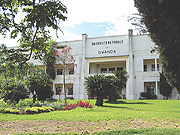It was with surprise that I read that the administration of the National University of Rwanda had decided to end the private intake scheme that was introduced just a few years back [The New Times issue No. 13732] effective the academic year 2009.


It was with surprise that I read that the administration of the National University of Rwanda had decided to end the private intake scheme that was introduced just a few years back [The New Times issue No. 13732] effective the academic year 2009.
According to the report, the reason cited by the Academic Senate was the lack of "physical infrastructure and lack of human capacity”.
The National University’s media advisor, Jean Bosco Rushingabigwi, said that the facilities at the main campus were overstretched…the student-teacher ratio is very high…which makes a student centered system of teaching and learning difficult”.
While, as a former student, I will not deny the fact that the university facilities are, and have been, overstretched for a long time; I’m wondering whether the university council used a machete when they could have used a scalpel to find a solution to the obvious problem of too many students in comparison with the facilities the university can avail to its students.
Aren’t the private students being scapegoat-ed?
Everyone knows that Rwanda is attempting to build itself as a knowledge-based economy; therefore, it’s imperative that all opportunities to give an education to as many Rwandans as possible.
Certainly, great numbers of semi-baked students shouldn’t be allowed into the job market…but are we really in a position to be choosy?
I mean, here are the general statistics- there are about ten thousand students at the Butare-based campus, and the private student’s number not more than two thousand.
While a small number are full time students, the great majority of private students attend evening classes. So, it would be naïve to believe that students are crammed into classes like sardines in a can because of the large numbers of private students.
If students are indeed crammed, it’s because the government sponsored students are extremely numerous.
It seems that the rationale of the move wasn’t, however, one to give the overstretched facilities a breather.
According to the aforementioned media advisor, the move was made to make it possible for the university to implement a new system of learning that would require "students do most of their learning on their own…this requires enough educational learning materials and other technological equipment like projectors and computers…the university is constrained in these areas and therefore can no longer support more private intakes”.
So, if I’m not mistaken, the Senate, has taken a decision to remove the possibility of a first class education (in the Rwandan context anyway) to those who haven’t been able to get there on government sponsorship, not because the ancient infrastructure wont be able to handle the influx, but rather because of a ‘new teaching system’?
A system in which the student is supposed to do his/her own research? That doesn’t make any sense because if, suppose I’m a student, I’m doing my own research in the library and the Internet, how will the fact that there are a few ‘extra’ private students affect my research?
Honestly, I can’t understand the rationale. More especially when one remembers the fact that the large majority of the private students undergo evening courses.
If the university administration really wanted to raise the standard at the creaking institution, they would have, in my humble opinion, been better served if they expanded the library, finished the student hostels and got more, and better trained teaching staff.
Refusing to give a few thousand potential students a chance of a good university education isn’t the cure to the ills…and, need I say it…it isn’t a cure for anything at all.


